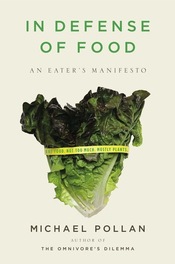
As promised, though a bit late, here are some general guidelines for buying and consuming food as suggested by Michael Pollan in the ending chapters of In Defense of Food.
He covers a lot of ideas while giving some advice and I will summarize here some of the ones I think are key. I really recommend reading the book for some great stories, examples, and information in addition to more detailed advice!
1. “Eat food.”
When it comes to eating, humans have evolved to eat natural plant and animal products. A vast amount of the food found in markets and on shelves, however, have been processed past the point of recognition. Pollan suggests eating things that your great-grandparents would still be able to identify as food. He makes the point that all the whole foods tend to be on the outsides of the supermarket (in the produce, meat, and dairy sections). So stay away from those boxed goodies that big companies spend all that advertising to get you to buy it!
2. “Mostly plants.”
Humans have also evolved to be mostly herbivorous. We still don’t fully understand what processed foods do for our health, and we won’t know for a long time. There is that quote that supposedly a Japanese person said where they would wait to see what happens to the Americans with their Western Diet before trying it, much like a nutrition/health experiment.
Though many processed foods are claimed to be full of nutrients and other things good for our health, the nutrients and other things did not occur naturally in the food product. They were somehow injected or supplemented in the product. We can’t be sure that this way these nutrients are being brought into our body are actually efficient or beneficial. We should stick to what we are sure of, which are the plants and combinations of them in certain cuisines that have proven to be good for our bodies.
(On a side rant, plants have really gotten a bad rap in American culture. Plants have become the side dish to increasingly unhealthy entrees of meat. It will be difficult to work plants out of the negative stigma that many people have, but there is progress being made. HOWEVER, I’m tired of people asking me if I am a vegetarian just because I like to eat mostly plants. Just because my meal is NOT 80% meat, does not mean that I’m a hippy, veggie-loving vegetarian or vegan, though a part of me might be. It should not be the alternative lifestyle to eat more plants than meat. It should be THE lifestyle.)
3. “Not too much.”
Portions are out of control in this country. It has become somewhat of an expectation among Americans that for a small buck you can get a plateful of fried food. Studies have suggested that Americans eat until there is none left in the bag, on the plate, etc., instead of assessing their physical state of fullness. Some European cultures have been shown to be better at this, while they also tend to enjoy their food in meals that are take more time and are more social. Taking more time to eat means the body has more time to realize it is receiving food, and also makes food a more cultural experience.
Thanks for reading! Comments are welcome, as always!
One thought on “Eater’s guidelines…attempts at making sense of it all”